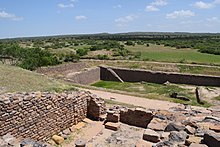Bronze Age (c. 3300 – c. 1800 BCE)
Indus Valley Civilisation
The Bronze Age in the Indian subcontinent began around 3300 BCE. Along with Ancient Egypt and Mesopotamia, the Indus Valley region was one of three early cradles of civilization of the Old World. Of the three, the Indus Valley civilisation was the most expansive,[46] and at its peak, may have had a population of over five million.[47]
The civilisation was primarily centered in modern-day Pakistan, in the Indus river basin, and secondarily in the Ghaggar-Hakra River basin in eastern Pakistan and northwestern India. The mature Indus civilisation flourished from about 2600 to 1900 BCE, marking the beginning of urban civilisation on the Indian subcontinent. The civilisation included cities such as Harappa, Ganeriwala, and Mohenjo-daro in modern-day Pakistan, and Dholavira, Kalibangan, Rakhigarhi, and Lothal in modern-day India.
Inhabitants of the ancient Indus river valley, the Harappans, developed new techniques in metallurgy and handicraft (carneol[further explanation needed] products, seal carving), and produced copper, bronze, lead, and tin. The civilisation is noted for its cities built of brick, roadside drainage system, and multi-storeyed houses and is thought to have had some kind of municipal organisation. Civilization also developed a Indus script, which is presently undeciphered.[49] This is the reason why Harappan language is not directly attested, and its affiliation uncertain. [50] A relationship or membership of the Dravidian or Elamo-Dravidian language family is proposed by some scholars.[51][52]
After the collapse of Indus Valley civilisation, the inhabitants of the Indus Valley civilisation migrated from the river valleys of Indus and Ghaggar-Hakra, towards the Himalayan foothills of Ganga-Yamuna basin.[53]
Ochre Coloured Pottery culture
During 2nd millennium BCE, Ochre Coloured Pottery culture was in Ganga Yamuna Doab region. These were rural settlement with agriculture and hunting. They were using copper tools such as axes, spears, arrows, and swords. The people had domesticated cattle, goats, sheep, horses, pigs and dogs.[55] The site gained attention for its Bronze Age solid-disk wheel carts, found in 2018,[56] which were interpreted by some as horse-pulled "chariots".[57][58][note 1]






Comments
Post a Comment